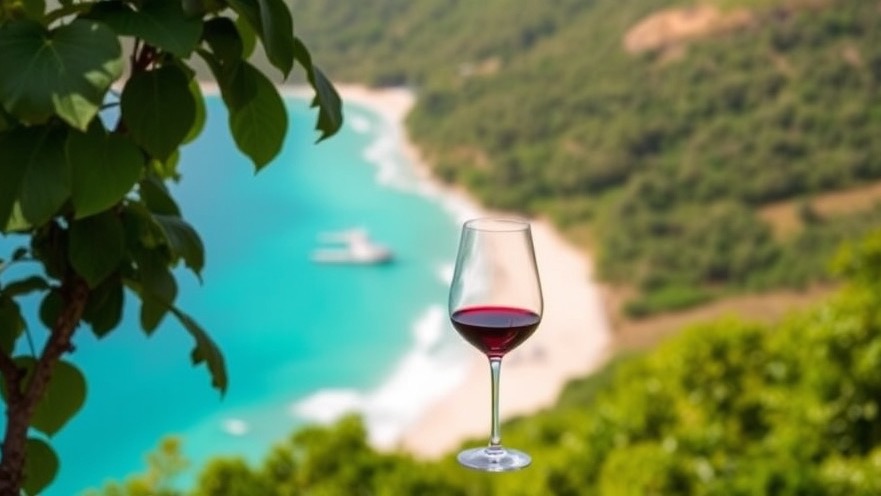
While the Caribbean is more commonly known for its rum, stunning beaches, and tropical cocktails, there’s a growing wine culture emerging in the region. A place of sun-soaked vineyards, island-grown fruits, and innovative winemaking, the Caribbean has begun to make its mark on the world of wine. If you’re a wine enthusiast looking for something unique, the Caribbean is a destination you might not have considered—yet.
Though the region's wine scene is still young compared to European counterparts, many islands are cultivating vineyards and producing wines that reflect the terroir, history, and culture of the region. From the lush hills of Jamaica to the sun-kissed slopes of St. Lucia, the Caribbean wine industry is as diverse as its landscape.
JAMAICA: A New Wave of Vines
In Jamaica, an island better known for its reggae music and jerk cuisine, wine lovers are discovering an emerging wine scene. In the parish of St. Elizabeth, Jamaica’s first commercial vineyard, The Jamaica Wine Estate, has been gaining attention. This small estate, which produces a selection of wines using locally grown grapes, offers a unique taste of the island. Known for its rich volcanic soil, Jamaica provides the ideal conditions for growing grapes that impart a distinct flavor profile—slightly earthy with tropical fruit notes.
The estate’s signature wine, Jamaica Red, is a vibrant blend of grape varieties, while the Jamaica White presents refreshing tropical flavors, making it perfect for the island’s warm climate. Tours of the vineyard allow visitors to taste the wines while learning about the island’s unique winemaking techniques.
THE VIRGIN ISLANDS: Wineries with a Coastal Twist
The U.S. Virgin Islands, known for its pristine beaches and laid-back lifestyle, are also home to several small wineries that specialize in fruit wines made from local produce. These wineries focus on incorporating tropical fruits like mango, passion fruit, and guava into their wines, creating light, refreshing alternatives to traditional grape-based varieties.
Caribbean Fruit Wine, a popular local brand, blends local fruits with grapes to create wines that are smooth, sweet, and full of tropical flair. These wines are perfect for a beachside sunset or paired with the fresh seafood found throughout the islands.
ST. LUCIA: Island Wines with French Influence
Known for its stunning landscapes and the towering Pitons, St. Lucia is now gaining attention as a growing wine destination. The island’s vineyard, St. Lucia Vineyards, situated on the volcanic slopes, is the pride of the island’s wine culture. The vineyards are often compared to some of the best wine-growing regions in the world, thanks to their rich volcanic soil and perfect sunlight.
The island’s most well-known wine is its Piton Valley Chardonnay, made with grapes grown in the region’s rich volcanic soil. The wine’s tropical fruit undertones and crisp acidity make it an excellent complement to the island’s fresh fish dishes and local cheeses. For those visiting, wine tours offer a chance to sip some of the finest wines while enjoying breathtaking views of the Pitons, a UNESCO World Heritage Site.
BARBADOS: The Island’s Unique Wine Experience
Barbados, often called the birthplace of rum, is now home to an exciting and innovative wine culture. Although the island has only a few small-scale wineries, it’s attracting wine enthusiasts with its unique take on winemaking. The West Indies Wine Company in Barbados produces a range of local fruit wines, including Caribbean Mango Wine, Passion Fruit Wine, and even Bajan Rum Wine, which blends Barbados’ rum heritage with a fruity twist.
The winery’s fruit wines offer a unique taste of the islands—light, refreshing, and full of tropical flavor. These wines are perfect for sipping on a hot afternoon or pairing with a meal of fresh seafood.
THE DOMINICAN REPUBLIC: A Vineyard with a View
The Dominican Republic is known for its stunning beaches and all-inclusive resorts, but it also has a growing wine scene, thanks to the Altos de Chavón Vineyards in the La Romana region. Inspired by French winemaking techniques, the vineyards produce a range of wines, from bold reds to crisp whites, using both local and international grape varieties.
The wines produced in the Dominican Republic have garnered attention for their distinctive flavors, which are a result of the island's unique climate and soil. The Altos de Chavón Merlot and Chardonnay are some of the best-known wines on the island, offering wine lovers a chance to explore the flavors of the Caribbean with a European touch.
WHY CARIBBEAN WINES ARE WORTH A SIP
Caribbean wines are still in the early stages of development, but they represent a growing passion for viticulture in the region. The Caribbean's climate offers the ideal conditions for cultivating grapes and fruits, while its history of European colonization has fostered the development of winemaking techniques. As the industry grows, more vineyards and wineries are emerging, showcasing the region’s ability to produce wines that are distinct, complex, and uniquely Caribbean.
For wine lovers, the Caribbean offers a chance to explore a new frontier of winemaking. Whether you’re visiting a tropical vineyard in Jamaica, tasting a local fruit wine in the Virgin Islands, or enjoying a glass of Piton Valley Chardonnay in St. Lucia, the wines of the Caribbean provide an exciting and refreshing way to experience the region’s culture and natural beauty.
VISIT THE VINEYARDS
For those interested in exploring the Caribbean wine culture firsthand, many of the islands offer vineyard tours and wine tastings, where visitors can sample local wines while learning about the winemaking process. It’s a unique opportunity to savor the flavors of the islands and discover how the Caribbean is carving its niche in the world of wine.
Whether you’re a seasoned oenophile or a casual wine drinker, a sip of Caribbean wine promises to add a new layer to your island experience.
 Add Row
Add Row  Add
Add 




Write A Comment